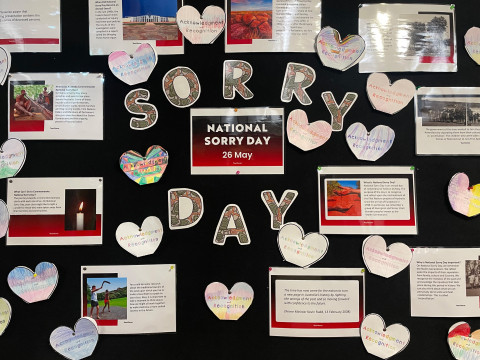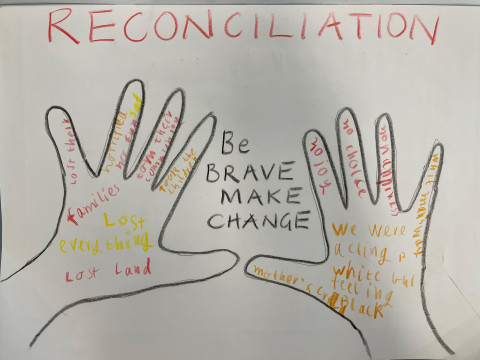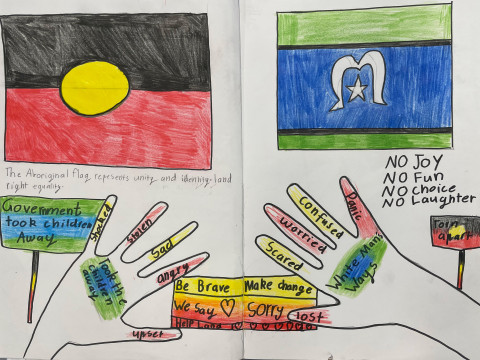Published 13 Oct 2023
Building cultural awareness and global connectedness - Sacré Cœur
Engaged with colleagues, school and the broader community
Brigit Keel – Global Connections Leader
Sacré Cœur
Schools and early childhood services across Victoria continue to provide quality learning experiences across all levels. The VIT’s Professional Practice team is privileged to see this work first-hand on visits to workplaces around the state. Here is just one example spotlighting the great work happening in a Victorian school.
Brigit Keel is the Global Connections Leader at Sacré Cœur, an independent Catholic girls’ school in Melbourne’s south east.
The 200-year-old school is part of a network of 150 sister schools across 41 countries. The Sacré Cœur community has long embraced celebrating culture, both locally and through its international roots. When the whole world stopped during the pandemic, Brigit Keel saw an opportunity to lead students in building their global awareness that might not otherwise have existed.
We spoke to Brigit about the award-winning initiatives that paved the way for learning about culture and connectedness on a local and international scale.
Q: Can you give some background to the development of your approach to the initiative including any research or established models / strategies that your approach is based upon?
In late 2020, I was appointed to the newly created role of Global Connections Leader, a position that resonated deeply with me due to my unique background.
Growing up in South Africa to Swiss parents, I had the privilege of witnessing the country's transformation as it emerged from the shadows of apartheid. As 2021 unfolded, the world was gripped by the COVID-19 pandemic, resulting in widespread lockdowns and the closure of international borders. In response to this global challenge, I seized the opportunity within my role to lead the development of our school's Reconciliation Action Plan (RAP), collaborating closely with a dedicated team of staff and students.
The lockdowns also provided an unexpected opportunity for me to spearhead the creation of an initiative called the Virtual Collaboration Program. This program, spanning schools across Taiwan, Japan, Australia and New Zealand within the Sacred Heart School Network, facilitated virtual meetings where seven Year 9 students from our school engaged with their counterparts every two weeks during each term. This student-led virtual exchange was designed to foster global awareness, build relationships and address current global issues aligned with the Sacred Heart goals, ultimately encouraging students to formulate local and global solutions.
From this initial project, our Global Citizenship program flourished. The Global Citizenship initiative empowered Year 5 students to participate in the Meg Global Citizenship Student Ambassador program, attend and present at the Victorian Youth Summit, and partake in cultural diversity and inclusion workshops. We continued to expand our horizons by fostering connections with sister schools worldwide, developing innovative projects for our students that encouraged cross-border collaboration in various educational domains.
In the time since, our immersion program has thrived, affording students the remarkable opportunity to embark on Indigenous Immersions and visit sister schools within the ANZNet community and beyond, enhancing their global perspectives and cultural awareness.
As the Global Connections Leader, my role has been instrumental in fostering a sense of global citizenship within our school community, encouraging students to embrace diversity, engage in meaningful dialogues, and work together towards a more interconnected world.

Q: What structural things are in place to ensure that the initiative has its best chance of success?
To ensure that our initiatives have the best chance at success, we have implemented several structural measures.
- Clear goals and objectives
We have established clear goals and objectives within our programs and the Reconciliation Action Plan (RAP). These goals are set, reviewed and adjusted annually. Additionally, we conduct a comprehensive review every three years of our RAP to ensure our initiatives remain aligned with our evolving vision and priorities. This ongoing evaluation process ensures we stay focused and adaptable in our pursuit of success.
- Curriculum audit
A crucial step in our strategy is the completion of a curriculum audit. This audit helps us assess the current state of our educational offerings and identify areas where Indigenous and global perspectives can be incorporated across all year levels and learning areas. By pinpointing these opportunities, we ensure our initiatives are integrated into the core of our educational approach, enhancing their impact and relevance.
- Virtual collaboration program
We maintain an active review and adaptation process for our virtual pollaboration program with sister schools. This ensures we are responsive to the changing needs of both our students and partner schools. By continually refining this program, we can maximise its effectiveness in facilitating meaningful cross-cultural exchanges and learning experiences.
- Global program expansion
We are committed to expanding our global programs to reach as many students as possible. By diversifying and broadening our program offerings, we aim to provide all students with the opportunity to participate. This inclusive approach not only maximises the reach of our initiatives but also ensures a diverse range of students can benefit from these enriching experiences.
All of our structural measures include clear goal-setting, regular review processes, curriculum integration, adaptability in collaboration programs and the expansion of global initiatives. These measures collectively contribute to the success of our initiatives by fostering alignment with our goals, responsiveness to changing needs and broad accessibility for all students.
Q: What are the greatest benefits to staff development of this approach?
Our staff and the broader educational community have benefited through:
Increased confidence and inclusivity
One of the most notable benefits has been the boost in staff members' confidence when it comes to including Indigenous perspectives in their curriculum planning. By providing staff with the knowledge and resources needed to integrate these perspectives, we have empowered them to create a more inclusive and culturally sensitive learning environment. This, in turn, enhances the educational experience for all students, fostering a more diverse and respectful classroom.
Interdisciplinary collaboration
The approach has encouraged learning areas to connect and collaborate more effectively. By weaving Indigenous perspectives into various subjects, staff members have been able to find common ground for interdisciplinary projects and activities. This not only enriches the curriculum but also mirrors the interconnectedness of Indigenous knowledge systems.
Global engagement
Our staff's engagement with Indigenous perspectives and global connectedness has transcended borders. The interest shown by Primary Staff in attending our Student Immersion Program to Cape York demonstrates a commitment to deepening their understanding of Aboriginal and Torres Strait Islander perspectives. This international outlook has also led to staff members connecting with our international schools. These connections have resulted in valuable collaborations, as staff members look to learn from and work together on programs that can benefit our students.
Cultural exchange
The program has facilitated meaningful cultural exchange experiences for our students. For example, our Japanese students are now connecting with sister schools across Japan, fostering cross-cultural understanding and global citizenship. This not only broadens their horizons but also creates opportunities for cultural enrichment and language learning.
Innovative program development
The collaboration with sister schools in Mexico, the US and Chile to develop an Indigenous spirituality course is a prime example. This initiative not only promotes cross-cultural understanding but also encourages the exchange of ideas and best practices in teaching Indigenous perspectives. It showcases the power of international collaboration in enhancing educational offerings.
Q: What have been the benefits to learner outcomes of this approach? Please provide some illustrative examples if appropriate.
Improved engagement
One of the most significant benefits has been a noticeable increase in student engagement. This is evident through their active use of voice and their heightened participation levels in our immersion programs spanning Years 8 to 11. Students are more eager to contribute, share their thoughts and actively participate in classroom activities.
Enhanced political awareness
Our Year 10 students have demonstrated a substantial improvement in their understanding of the current political environment. A striking example of this was their involvement in a mock referendum on The Voice. This exercise not only showcased their heightened awareness but also their ability to critically assess and engage with complex political issues.
Global problem solving
Another positive outcome has been the students' enthusiasm for addressing global issues. They are not only actively seeking solutions but also taking these ideas and solutions to external forums like the Victorian Youth Summit. This demonstrates their commitment to making a meaningful impact on real-world challenges, which is a crucial skill for their future endeavours.

Reconciliation artwork from learners at Sacré Cœur

Reconciliation artwork from learners at Sacré Cœur
Q: What plans does your workplace have to take this approach forward?
At my workplace, we have several plans in place to advance our approach. First and foremost, we are committed to a continuous process of review and adjustment of our current offerings. This ongoing evaluation ensures that we stay responsive to the evolving needs of our students and the broader educational landscape.
One significant aspect of our approach involves the incorporation of Indigenous perspectives into our curriculum across all learning areas and year levels. We are proud of the progress we have made in this regard, and our plan is to continue building on this foundation. We recognise the importance of promoting Indigenous knowledge, culture, and perspectives throughout our programs to foster inclusivity and a deeper understanding of the Aboriginal and Torres Strait Islander history and contributions.
Additionally, we are keen on expanding the programs we have already implemented. To achieve this, we will identify and prioritise future projects that align with our goal of providing students with a future fit learning environment. These projects will be carefully selected to ensure they reflect our dedication to delivering a high-quality and inclusive education, and our students are equipped with the skills and knowledge needed to excel in a rapidly changing world.
Do you have an example of outstanding work in your school or early childhood service? We’d like to consider showcasing it the Excellence in Teaching section of our website. Send your example and contact details to vitcomms@vit.vic.edu.au.
